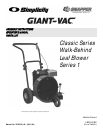
8
4 unit operation (cont.)
GENERAL RULES TO OBSERVE BEFORE
AND DURING OPERATION:
• Inspect your unit before each and every use. Check for worn, bent or broken components, loose fasteners, low or flat
tires, etc., and repair or replace prior to operation. DO NOT OPERATE A MACHINE THAT IS WORN OR DAMAGED
– SERIOUS INJURY OR DEATH CAN RESULT.
• Clear the entire work area of all debris that could cause damage to or become entangled in the unit. Rocks and large
branches can wedge themselves between the impeller and housing, causing equipment damage or personal injury. If
in doubt, remove it.
• Do not start unit until you are ready to begin blowing, and promptly shut off unit as soon as operation is complete.
• Keep hands, feet and clothing away from rotating parts. Never place your feet or hands in path of discharge.
• Use proper discretion in selecting your debris removal pattern, especially on uneven terrain. Avoid steep hills, espe-
cially if surface is wet. Do not travel straight down slopes exceeding 14 degrees. If tires begin to slip when climbing a
slope, the grade is too steep for safe operation. Angle the unit to a less steep slope until tires stop slipping and trac-
tion is regained.
• Be keenly aware of your surroundings while operating unit – children and pets can pop out of nowhere.
• Learn to listen to your machine – being aware of what a well-running unit sounds like can alert you to a potential prob-
lem. A straining engine or clanging impeller means that trouble is almost sure to follow.
TO CHANGE AIR DISCHARGE DIRECTION:
• To direct air discharge out from the front of the machine,
open the forward air deflector door, mounted on the
front of the discharge end of the blower, by pushing the
control lever to the front of the machine. This feature is
ideal for such things as blowing debris from a wall or
fence. Adjust engine speed to increase or decrease air
discharge rate.
• To direct air discharge out from the side of the machine,
close the forward air deflector door by pulling the control
lever toward the back of the machine. This feature is
ideal for such things as blowing debris into neat rows.
Adjust engine speed to increase or decrease air dis-
charge rate.
HINTS FOR EFFECTIVE OPERATION:
• For operator ease and maneuverability, push down on the upper handle while walking so that the machine balances
on the rear wheels.
• When blowing dry debris, set blower discharge to lower rate; when blowing wet or frozen debris, increase discharge
rate.
SIDE
FRONT


















